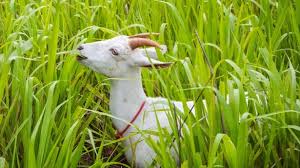 Scientists have discovered a ‘Super grass’ that can not only help mitigate the environment against over a third of greenhouse emissions but also increase crop yields by about 50 percent and lessen the use of nitrate fertilizer. These revelations have lightened a ray of hope in the management and tackling climate through agriculture especially livestock industry which has been blamed for being responsible for about a third of greenhouse emissions globally
Scientists have discovered a ‘Super grass’ that can not only help mitigate the environment against over a third of greenhouse emissions but also increase crop yields by about 50 percent and lessen the use of nitrate fertilizer. These revelations have lightened a ray of hope in the management and tackling climate through agriculture especially livestock industry which has been blamed for being responsible for about a third of greenhouse emissions globally
The new discovery about the grass which is known through its scientific name as Brancharia was arrived at by a team of scientists from International Center for Agriculture. The scientists’ new evidence demonstrates that a potent chemical mechanism operating in the roots of the tropical grass used for livestock feed has enormous potential to reduce greenhouse gas emissions. Through a process referred to as “biological nitrification inhibition” or BNI, the mechanism markedly reduces the conversion of nitrogen applied to soil as fertilizer into nitrous oxide, according to papers prepared by the CIAT scientists.
Nitrous oxide is the most powerful and aggressive greenhouse gas, with a global warming potential 300 times that of carbon dioxide. “Nitrous oxide makes up about 38 percent of all greenhouse gas emissions in agriculture, which accounts for almost a third of total emissions worldwide,” said Michael Peters, who leads CIAT’s research on tropical forages. “BNI offers what could be agriculture’s best bet for keeping global climate change within manageable limits.”
The scientists who have authored several papers on this grass, which is already used in pastures across much of Latin America, say enhanced strains, wider usage and improved management will provide the most effective means of tackling climate change through agriculture, which accounts for about a third of all greenhouse gases. Nitrous oxide largely from livestock production makes up 38 percent of agriculture emissions, but this share could be substantially reduced, they noted.
The grass which scientists have been researching for over the last decade is said to thrive well in tropical climate and is also taunted to have a huge economic benefit to farmers especially smallholder ones in the developing countries. “Livestock production provides livelihoods for about a billion people, but it also contributes about half of agriculture’s greenhouse gas emissions,” Peters explained. “BNI is a rare triple-win technology that’s good for rural livelihoods as well as the global environment and climate. It defies the widespread notion that livestock are necessarily in the minus column of any food security and environmental calculation.”
CIAT researchers have found ways to increase BNI through plant breeding in different species of Brachiaria grasses. During the past decade, scientists have discovered the chemicals that enable the plant to bind nitrogen into the soil, thus making it more productive and less "leaky". As a result of the properties of the grass to bind more nitrogen into the soil, the Center scientists have also gathered evidence that a maize crop grown after Brachiaria pastures gave good yields with only half the amount of nitrogen fertilizer normally used, because more nitrogen was retained in the soil, thus reducing nitrous oxide emissions and nitrate leaching. This is also confirmed by the scientists with Subbarao noting, “The problem is that today’s crop and livestock systems are very ‘leaky. About 70 percent of the 150 million tons of nitrogen fertilizer applied globally is lost through nitrate leaching and nitrous oxide emissions; the lost fertilizer has an annual estimated value of US$90 billion and the new discovery will greatly try to mitigate this fact.”
















Comments powered by CComment